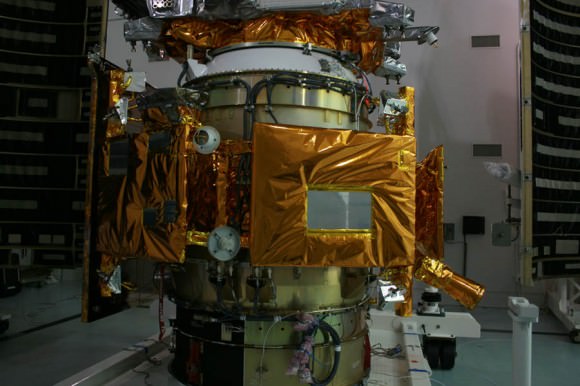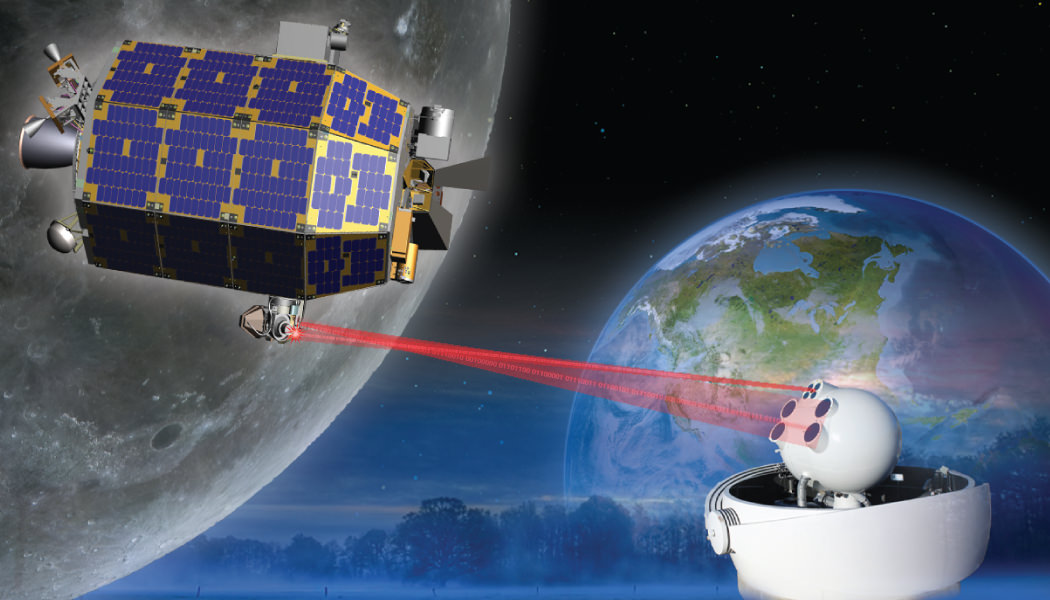In an exclusive new interview with Universe Today, NASA’s Ames Research Center Director Pete Worden was “very excited” to discuss the historic Moon Shot set to launch NASA’s LADEE lunar orbiter from the Virginia coast and the NASA Wallops Island facility on Friday night, Sept. 6, that boasts “a new modular design” that can revolutionize how we explore our solar system “with robotic orbiters, landers and rovers” – and is aimed at “answering fundamental science questions.”
“LADEE is the first in a new class of interplanetary exploration missions,” NASA Ames Director Worden told Universe Today. NASA Ames leads the LADEE mission. “It will study the pristine moon to study significant questions.”
“And it will demonstrate a new modular approach that will give us science at a lower cost. We are very excited.”
“It will tell us a lot about the moon,” Worden told me.
When America returns to the Moon with the LADEE spacecraft blasting off shortly before midnight Sept. 6, it could potentially be watched by many tens of millions of spectators – weather permitting – along the US East Coast stretching from Maine to the Carolina’s and into parts of the Midwest. See launch visibility map below.
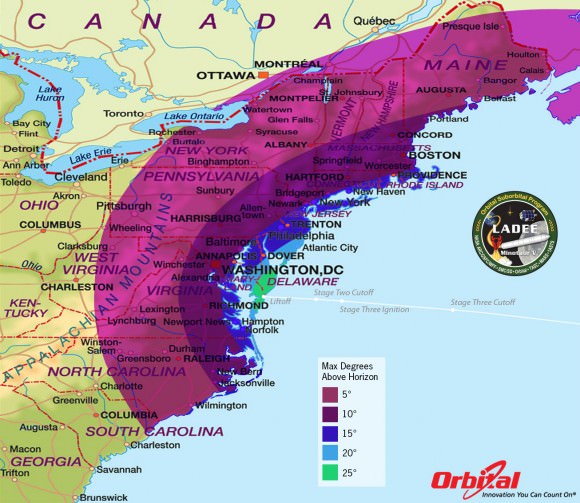
The LADEE nighttime launch will be visible to millions of spectators across a wide area of the Eastern US -weather permitting. This map shows the maximum elevation (degrees above the horizon) that the Minotaur V rocket will reach during the Sep. 6, 2013 launch depending on your location along the US east coast. Credit: Orbital Sciences
And the science timing for LADEE’s lunar mission is just perfect as well since several countries and corporations are gearing up to dispatch a batch of new orbiters and landers to Earth’s nearest neighbor that could change its character forever.
“This is probably our last best chance to study the pristine Moon before there is a lot of human activity there changing things.”
The purpose of LADEE’s trio of science instruments is to collect data that will inform scientists in unprecedented detail about the ultra thin lunar atmosphere, environmental influences on lunar dust and conditions near the surface.
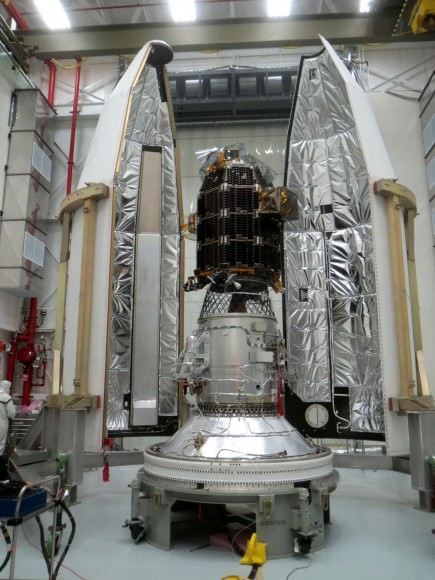
The couch sized probe is built on a ‘modular common spacecraft bus’, or body, that could be implemented on space probes to explore a wide variety of targets in the solar system.
“We think the modular bus is a winner,” Worden explained to Universe Today.
“LADEE could lead to other low cost missions to orbit and even land on the Moon, near Earth asteroids, Mercury and also the moons of Mars.”
“The LADEE bus is a strong contender for future NASA planetary missions, especially landers on bodies with a tenuous atmosphere. And small micro-rovers are possible too. We are really proud of it!”
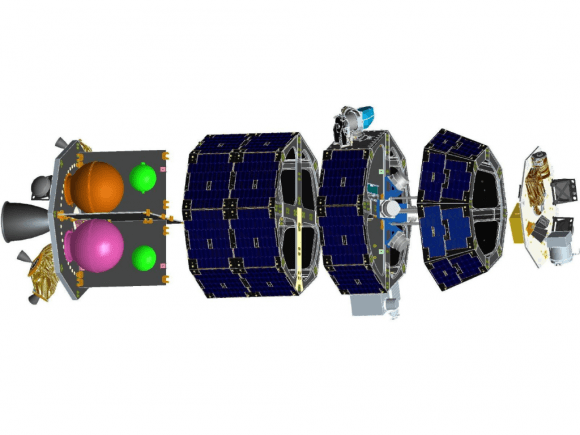
LADEE is NASA’s first ever planetary mission to launch from the Eastern Shore of Virginia at NASA’s Wallops Flight Facility on Wallops Island. The blastoff is expected to draw large crowds. Some local hotels are already sold out.
The Lunar Atmosphere and Dust Environment Explorer (LADEE) Observatory is NASA’s next mission to the Moon.
It thunder’s to space at 11:27 p.m. Friday, Sept. 6, from launch complex 0B at NASA’s Wallops Island facility and the Mid-Atlantic Regional Spaceport (MARS) atop the maiden flight of the new, solid fueled Minotaur V rocket developed by Orbital Sciences Corp.
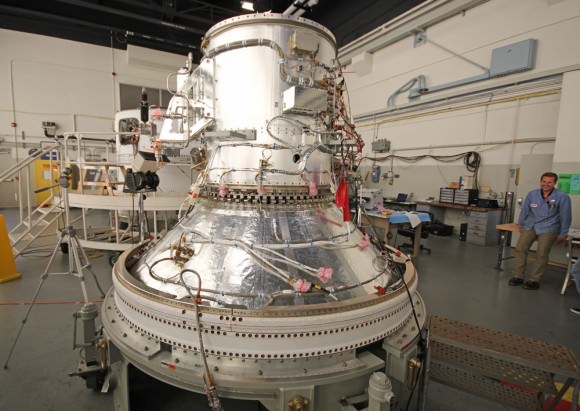
Close-up view of STAR 37 5th stage solid fuel motor for inaugural Minotaur V rocket launch at NASA Wallops rocket facility will propel LADEE into its lunar transfer orbit. LADEE will be mounted on top and surrounded by the payload fairing attached at bottom ring. Credit: Ken Kremer/kenkremer.com
The goal of the $280 Million mission is to gain a thorough understanding of long-standing unknowns about the tenuous atmosphere, dust and surface interactions that will help scientists understand other planetary bodies as well.
“After Apollo, the amazing thing is that we opened as many questions as we answered,” said Worden. “One of the key issues is – What is the environment on the Moon’s surface from the lunar day to the lunar night?”
“And what are the limitations that would place on our activities there?”
“Although the moon has a tenuous atmosphere it’s actually very active and interacts very strongly with the solar wind. It may produce something that on Earth we would call a ‘dust storm’.”
“We also wish to have the ‘ground truth’ [measurements] of the Moon’s environment before humans change things.”
And change is inexorably coming to the Moon rather soon.
“The Chinese plan to land on the Moon by year’s end,” Worden elaborated.
“What we found during Apollo is that an artificial disturbance very considerably changes the Moon’s atmosphere – or exosphere.”
“So we really want to known the pristine state of the lunar exosphere before its changed by human activity.”
“The data we have from Apollo surface measurements shows that it took many months for the lunar exosphere to go back to its pristine state.”
“Now there are probably a half dozen to a dozen programs planning to land on the Moon in the next decade. So we may never see the Moon’s pristine state again!”
“So these are pretty significant questions that we will have an opportunity to answer with LADEE.”
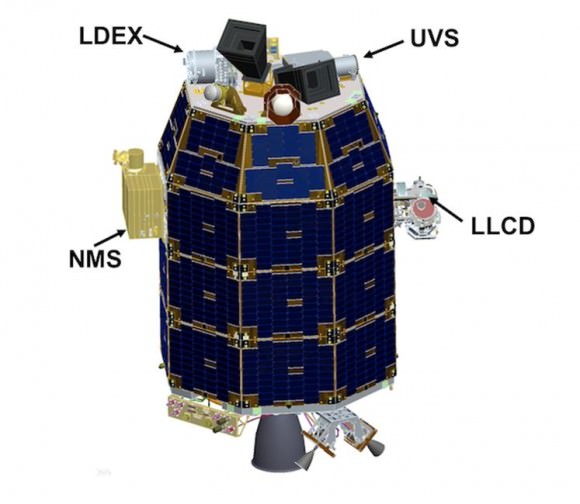
LADEE is the first spacecraft of any kind that’s been designed, developed, built, integrated and tested at NASA’s Ames Research Center in Moffett Field, Calif.
“This is our first complete mission built out at Ames,” Worden explained.
“It’s also the first of a new paradigm where we are trying to develop a low cost modular bus design.
The approach on LADEE was to make it a mix and match modular bus – rather than a singular modular bus.
“So we have modular slices that use a propulsion stage, lander stage, communications stage, science payload stage, bus housekeeping stage and more,” Worden told me.
“In the past many others tried to build a ‘one size fits all’ modular bus. But it turns out that one size does NOT fit all needs.”
“So we took a page from how you build desktop computers.”
“We put in different modules that you can expand or subtract much more easily without changing the whole fundamental architecture or design.”
“So assuming this works well, I think you will see a lot more missions. And that makes it really exciting as our first mission.”
And the Ames modular bus has definitely sparked entrepreneurial interest.
“The bus is already an approach being used by at least one of the Google Lunar X-Prize competitors! The Moon Express team has looked at it a lot to transition that capability to them,” Worden explained.
How about future NASA missions?
“The LADEE bus is also a key part of several of our Ames proposals for future planetary missions,” Worden replied.
“The original design concept about seven years ago was for a small lunar lander. The lander propulsion would likely be a solid fueled stage.”
“Ultimately, NASA decided to go with the orbiter instead. And that showed the strength of the modular bus design – that it was very easy to change it from a lunar lander to the LADEE mission orbiter studying the lunar exosphere.”
I asked if it could deploy a small rover too?
“Yes- a small, micro rover is possible, perhaps 10 to 20 inches in size. And you could pack a lot of science on the small rover using today’s technology!
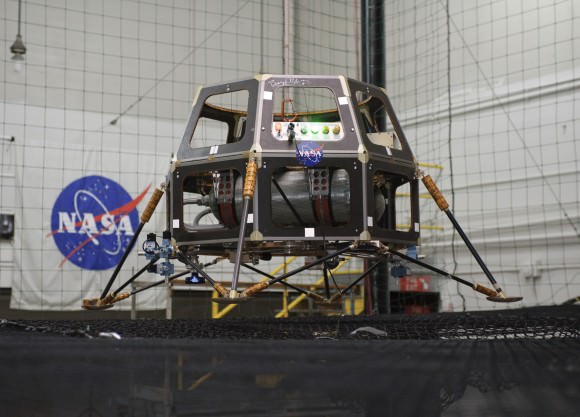
Thus there are numerous exploration possibilities – all dependent on the Federal budget for NASA in this extremely difficult fiscal environment.
NASA Ames had “built parts and spacecraft components and science instruments before, but not a spacecraft in the entirety and in house,” Worden told Universe Today.
For example, a few years back Ames built the LCROSS lunar impacting spacecraft that smashed into the Moon’s south pole and discovered a treasure trove of water ice.
LCROSS piggybacked as a secondary science mission payload onto NASA’ s Lunar Reconnaisannce Orbiter (LRO) when the duo launched from Cape Canaveral, Florida atop an Atlas V rocket.
NASA Ames has now taken the next step – having designed and built the whole LADEE spacecraft from beginning to end.
“This is our first real baby. It’s very exciting,” beamed Worden.
“LADEE is a pretty phenomenal mission.”
They say “Virginia is for Lovers’
Well coming this Friday, “Virginia is for Space Lovers too!”
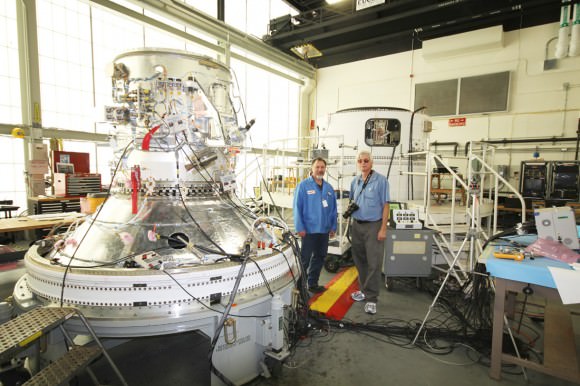
And remember that NASA has a 2nd historic launch from Wallops slated for Sep. 17 – with blastoff of the Orbital Sciences Antares rocket and Cygnus cargo carrier bound for its 1st flight to the International Space Station (ISS).
Be sure to watch for my continuing LADEE and Antares mission reports from on site at NASA’s Wallops Launch Pads in sunny Virginia – reporting for Universe Today.
…………….
Learn more about LADEE, Cygnus, Antares, MAVEN, Orion, Mars rovers and more at Ken’s upcoming presentations
Sep 5/6/16/17: “LADEE Lunar & Antares/Cygnus ISS Rocket Launches from Virginia”; Rodeway Inn, Chincoteague, VA, 8 PM
Oct 3: “Curiosity, MAVEN and the Search for Life on Mars – (3-D)”, STAR Astronomy Club, Brookdale Community College & Monmouth Museum, Lincroft, NJ, 8 PM
Oct 9: “LADEE Lunar & Antares/Cygnus ISS Rocket Launches from Virginia”; Princeton University, Amateur Astronomers Assoc of Princeton (AAAP), Princeton, NJ, 8 PM
